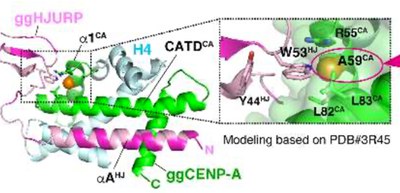
Mechanisms and evolution of amino acids necessary for cell division clarified
A group of researchers from Osaka University conducted a comprehensive analysis of mutants in chicken cells and clarified that amino acid sequences of centromere protein A (CENP-A), a variant of histone H3 DNA binding protein, were important for human cell division.
Cells multiply through cell division, grow, and form an individual. During cell division, the faithful inheritance of each cell's genetic information from one generation to the next is carried out by chromosome segregation. During cell division, microtubules of the mitotic spindle attach to kinetochores to transport the gene information contained in chromosomes. The genetic locus on the chromosome where kinetochores bind to the microtubules is called the centromere.
Defects in chromosome segregation can lead to birth defects or cancer. A kinetochore is formed only on the centromere, but the factor determining where the kinetochore assembles was unknown.
In this study, the researchers generated a CENP-A conditional knockout chicken DT40 cell line and introduced various mutants of CENP-A into CENP-A knockout cells. The A59Q mutation (CAA59Q) in CENP-A knockout cells did not localize to centromeres. Thus, they concluded that the alanine residue (A59) in the α1-helix of CENP-A was essential for its function.
Since amino acid serine 68 (S68) in human CENP-A, which corresponds to alanine 59 (A59) in chicken CENP-A, is also present in the CNEP-A of vertebrates, it is suggested that the amino acid is evolutionarily conserved.
In humans, arginine residue, a specific amino acid that non-mammalian vertebrates do not have, is present and enhances binding affinity to CENP-A in the chaperone HJURP, which binds to CENP-A and mediates its deposition at centromeres.
In addition, the group demonstrated that mouse CENP-A S62 was essential for cell viability and that CENP-AS62Q did not localize to centromeres in mouse ESCs. From these findings, the group concluded that arginine residues of CENP-A vary between species.
The discovery of the amino acid sequence that serves as a key to interaction between CENP-A and its support factor HJURP will lead to the development of drugs from different perspectives. The understanding of chromosome segregation at the molecular level based on the results of this group’s research will facilitate applied research to develop drugs for treating cancer and chromosomal diseases caused by aberrant chromosome segregation.
Figure 1
Figure 2
Figure 3
Figure 4
Figure 5
The article, “Essentiality of CENP-A depends on its binding mode to HJURP,” was published in Cell Reports at DOI: https://doi.org/10.1016/j.celrep.2020.108388.
